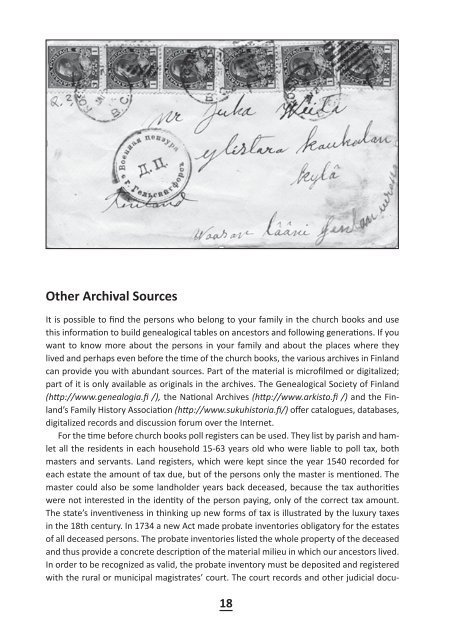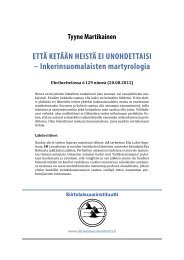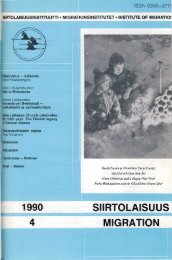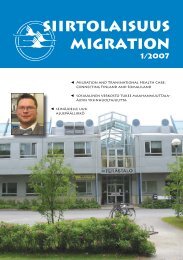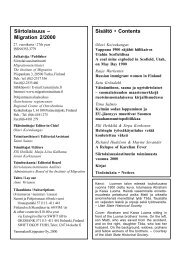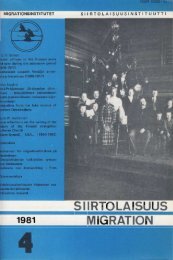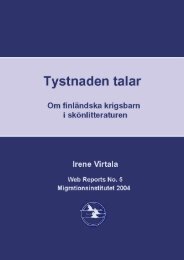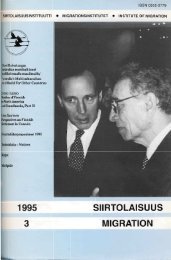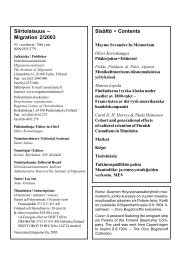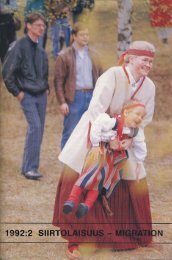How to trace your roots in Finland - Siirtolaisuusinstituutti
How to trace your roots in Finland - Siirtolaisuusinstituutti
How to trace your roots in Finland - Siirtolaisuusinstituutti
You also want an ePaper? Increase the reach of your titles
YUMPU automatically turns print PDFs into web optimized ePapers that Google loves.
Other Archival Sources<br />
It is possible <strong>to</strong> f<strong>in</strong>d the persons who belong <strong>to</strong> <strong>your</strong> family <strong>in</strong> the church books and use<br />
this <strong>in</strong>formation <strong>to</strong> build genealogical tables on ances<strong>to</strong>rs and follow<strong>in</strong>g generations. If you<br />
want <strong>to</strong> know more about the persons <strong>in</strong> <strong>your</strong> family and about the places where they<br />
lived and perhaps even before the time of the church books, the various archives <strong>in</strong> F<strong>in</strong>land<br />
can provide you with abundant sources. Part of the material is microfilmed or digitalized;<br />
part of it is only available as orig<strong>in</strong>als <strong>in</strong> the archives. The Genealogical Society of F<strong>in</strong>land<br />
(http://www.genealogia.fi /), the National Archives (http://www.arkis<strong>to</strong>.fi /) and the F<strong>in</strong>land’s<br />
Family His<strong>to</strong>ry Association (http://www.sukuhis<strong>to</strong>ria.fi/) offer catalogues, databases,<br />
digitalized records and discussion forum over the Internet.<br />
For the time before church books poll registers can be used. They list by parish and hamlet<br />
all the residents <strong>in</strong> each household 15-63 years old who were liable <strong>to</strong> poll tax, both<br />
masters and servants. Land registers, which were kept s<strong>in</strong>ce the year 1540 recorded for<br />
each estate the amount of tax due, but of the persons only the master is mentioned. The<br />
master could also be some landholder years back deceased, because the tax authorities<br />
were not <strong>in</strong>terested <strong>in</strong> the identity of the person pay<strong>in</strong>g, only of the correct tax amount.<br />
The state’s <strong>in</strong>ventiveness <strong>in</strong> th<strong>in</strong>k<strong>in</strong>g up new forms of tax is illustrated by the luxury taxes<br />
<strong>in</strong> the 18th century. In 1734 a new Act made probate <strong>in</strong>ven<strong>to</strong>ries obliga<strong>to</strong>ry for the estates<br />
of all deceased persons. The probate <strong>in</strong>ven<strong>to</strong>ries listed the whole property of the deceased<br />
and thus provide a concrete description of the material milieu <strong>in</strong> which our ances<strong>to</strong>rs lived.<br />
In order <strong>to</strong> be recognized as valid, the probate <strong>in</strong>ven<strong>to</strong>ry must be deposited and registered<br />
with the rural or municipal magistrates’ court. The court records and other judicial docu-<br />
18


